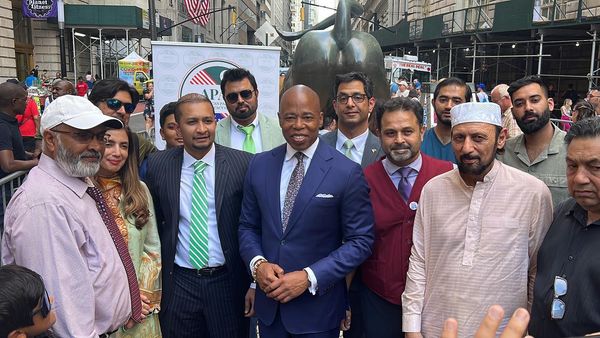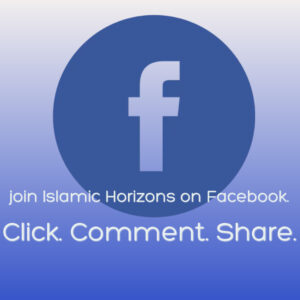Pakistani Americans remain fused to Islam and speakers of the graceful, poetic Urdu and their regional languages
By Misbahuddin Mirza
November/December 2022
“Welcome to Little Pakistan,” proclaim the huge green light post banners along Coney Island Avenue in Brooklyn, N.Y. The street scene appears to be right out of a modern Pakistani city, complete with men and women walking around in their traditional shalwar-qameez attire.
All shop signs are in Urdu and English. Restaurants bearing the names of Pakistani cities such as Lahori Chilli display mouthwatering delicacies. Their special clay tandoori ovens churn out amazing-looking naan (leavened bread), while chefs keep replenishing trays of delectable biryani and seekh to chapli and Bihari kabobs. Each morning, these restaurants serve their breakfast special: a halwa and puri (wafer thin puffy bread) combination topped with golden brown tea.

Clothing stores bristle with customers, and grocery stores sell everything from fresh halal meat to prized mangoes imported from Pakistan. Jewelry stores, dazzling the shoppers with their golden products, signify Pakistani Americans’ arrival in an extremely niche market.
Talking to Wilfred Chan of the U.K.-based The Guardian (Sept. 7), Fareeha Haq, a staffer at the Council of Peoples Organization, a Little Pakistan nonprofit, pointed out, “You can walk out in your traditional clothes and you don’t look awkward. You can get everything you want that would do in Pakistan — there’s a guy who sells sugarcane juice, just like home.”
The area’s crown jewel is the Grand Makki Masjid. The numerous Islamic calligraphy panels etched on its exterior marble wall reminds you of Quranic calligraphy etched on the red sandstone walls and marble inlay work of Qutb Minar’s Alai Darwaza in Delhi. The newly rebuilt three-story mosque’s final phase — completing two imposing minarets — is underway. This architectural masterpiece functions as the focal point of local Pakistani life, from launching Pakistan Day parades to religious and cultural events. The stores on both sides of Coney Island Avenue for half a linear mile roughly centered from the mosque are owned or operated by Pakistani Americans, and numerous Pakistani families live in the area.
The community celebrates Pakistan’s Independence Day (Aug. 14) and organizes Coney Island Avenue’s famous Brooklyn Mela at (also known as Little Pakistan), in which the Pakistani American Law Enforcement Society participates. The Pakistani American Youth Organization seeks to uplift and support needy community members excel in academics and other fields, runs a food pantry and distributes essential school supplies to families.
These South Brooklyn Pakistani Americans quickly responded to this year’s devastating floods in Pakistan. The Guardian noted that “Lahori Chilli, a busy Punjabi restaurant in the heart of Little Pakistan, has raised over $10,000 just by asking people to ‘donate generously’ to three large plastic jars, according to a restaurant worker, Saeed.”
Community members have steadily moved up the prosperity ladder. Some entrepreneurs have become multimillionaires; nine of them are billionaires. Pakistani Americans have also made their mark in other fields such as media, art and the military. According to the U.S. Census Bureau, in 2019 500,000+ Pakistani Americans living in the U.S., a 35% increase from 2010. There are Urdu-language radio stations in areas with high Pakistani American populations. Numerous cable and satellite providers offer Pakistani channels such as Geo TV, ARY Digital and PTV.
Pakistani Americans started moving into this area in the 1980s. Islamic Horizons spoke to Syed Nasir Mahmood (chairman, New York State Board of Pharmacy; president emeritus, Pharmacists Society of the State of New York), one of the early arrivers. He played a key role in organizing attendance at the Makki Masjid, assisting the local Pakistani American community and establishing Punjab Pharmacy, the area’s first pharmacy. After sustained fundraising, Mahmood is now in Pakistan to help with flood relief operations.
Pakistani Americans have also entered politics. Among them are Omar Ahmed (mayor, San Carlos, Calif.) and Saghir Tahir (member, New Hampshire House of Representatives), Sadaf Jaffer, former (mayor of Montgomery Township, N.J. was elected to the New Jersey General Assembly from the 16th District in 2021, and Faiz Shakir worked as Bernie Sanders’ political advisor and campaign manager during his 2020 presidential campaign.
In the arenas of government and law we find Judge Zahid Quraishi of the U.S. District Court of New Jersey and Zainab Ahmad, a former assistant U.S. attorney for the Eastern District of New York and current prosecutor for the U.S. Department of Justice. She specializes in the investigation and prosecution of terrorism cases.
In the medical field, the Association of Physicians of Pakistani Descent of North America provides or participates in several social and charitable services, among them providing free mobile clinics in the U.S. and Pakistan, free or low-cost medical care in several states and fundraising when natural disasters strike. Besides other projects, its Muskan project performs operations on cleft lips.
An Ancient Land
Pakistan is home to the ancient Indus Valley civilization, one of the world’s three earliest civilizations. Its Harappa and Mohenjo-Daro languages remain undeciphered. It is a land with a present, a past, and hope for the future of a people of a geographic location — an area that is a mixture of so many races through the ages, the original Jats, the Scythians, the Parthians, the Greeks, the Persians, the Arabs, the Turks, the Mongols.
Since obtaining independence in 1947, the county’s population has surged from about 33 million to 236 million (2022 World Population Review figure). Its 220+ million Muslims makes it the largest Muslim country after Indonesia. The current growth rate, close to 2%, is expected to decline to less than 1% by 2050.
The people are mainly concentrated around the Indus River and its tributaries, which provide about two-thirds of the irrigation and residential-use water.
Another issue is deforestation. Fatima Khalid et al.’s paper “Deforestation Dynamics in Pakistan: A Critical Review” (2020), states “At the time of independence, Pakistan had 7% green cover but after Bangladesh’s separation in 1971, it was reduced to less than 5%. The forest cover (percentage of land cover) calculated by the World Bank in Pakistan was 1.91 as of 2015”.
The Arrival of Islam
Caliph Umar’s (‘alayhi rahmat; r.634-4) armies reached India when they defeated the Sassanid Empire and began launching expeditions eastward. Under Caliph Mu’awiya (r.661-80), Makran, located in present-day southwestern Pakistan, was subdued and fortified with a garrison. Sometime later, Muslims conquered and integrated Qusdar, Qandabil and al-Qiqan into the Umayyad Empire.
Islam arrived in the heartland of contemporary Pakistan at the beginning of the eighth century, when General Mohammed Bin Qasim led a mission to punish Raja Dahir for not complying with the demand of Hajjaj Bin Yousuf, the Umayyad governor of Iraq and the East, to punish the pirates who had abducted Muslim women. These pirates, known as both the Meds and the Bawarij, were a Scythian tribe who used their distinctive Barja pirate warships to pursue their livelihood. They lived in Sindh under the raja’s rule.
Mohammed Bin Qasim quickly overran the raja’s kingdom, annexed all areas up to and including Multan, and annexed the new province to the empire. It was administered by Umayyad and, later on, Abbasid governors. Turkish mercenaries (still non-Muslims) employed by Kashmir’s king prevented them from going any further. When the Abbasids became weak, the Arab Habbari dynasty ruled Sindh from 854 to 1024 and the Ismaili Shia, pledged to the Fatimids of Egypt, ruled Multan.
World history was forever changed when the Turks started converting in the ninth century. This fearless martial race would batter down everything in its path to bring the message of Islam into India all the way from the Himalayas to its southern tip. This drive started with Sultan Mahmud Ghazni (d.1030), a Persianized Turk who stamped out Fatimid influence in Multan and conquered large swathes of contemporary Punjab and Afghanistan. Sultan Muhammad Ghori (d.1206), another Persianized Turk, soon conquered all of northern India. Subsequent Turkic sultans swiftly overpowered the entire Subcontinent and are credited with laying the foundation of Muslim rule there.
Present-day Pakistan, ruled by Muslims for 1,000 years, became a British colony. The Muslims bravely resisted the British and, in the first war of independence (1857), joined with fellow Hindus to militarily defeat and expel them. In 1947 London partitioned the Subcontinent into independent India and Pakistan. Pakistan, comprising the Muslim-majority areas, lost its eastern wing — separated by 1,000+ miles of Indian territory — following India’s 1971 invasion and proclamation of Bangladesh.
Today, the Pakistani Americans are busy providing a stable Islamic footing and sound education to their children so that tomorrow’s torchbearers are better and well-equipped for the future.
Misbahuddin Mirza, M.S., P.E., a licensed professional engineer, registered in the States of New York and New Jersey, served as the regional quality control Engineer for the New York State Department of Transportation’s New York City Region. He is the author of the iBook Illustrated “Muslim Travel Guide to Jerusalem.” He has written for major U.S. and Indian publications.
Tell us what you thought by joining our Facebook community. You can also send comments and story pitches to [email protected]. Islamic Horizons does not publish unsolicited material.
